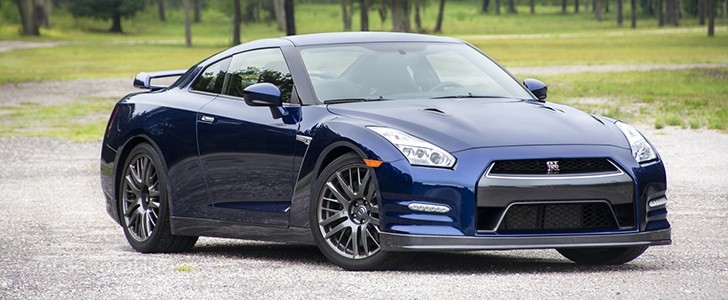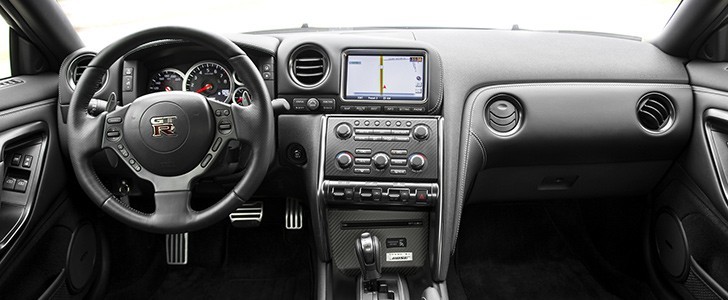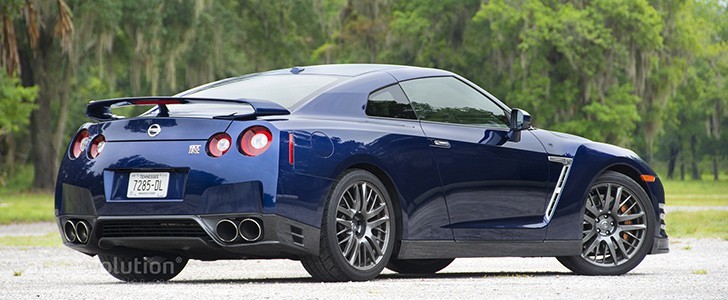Gtr 2016 Top Speed
Punishingly rewarding and brutally refined. After a full week with the 2016 Nissan GT-R, these are the best words I could come up with to describe this legendary supercar often referred to simply as "Godzilla." Everything about this car was unapologetically created for the sole purpose of speed, and even in its seventh year on the market, its performance continues to make the GT-R a benchmark among automakers and an icon for enthusiasts.

Over the years, I've had the pleasure of driving some of the best performance cars from around the world, but few have the kind of impact that the GT-R does. Driving around town, this car commands attention from car fans of all ages including grown adults almost getting whiplash trying to get a second look at the car and teenage boys hooting and hollering as they attempt to take a selfie with the GT-R rolling past. I even had a local police officer pull up while I was photographing the car. I expected him to ask me to leave the area, but instead he stopped to check out the GT-R and kept calling it "badass." I can't argue with him.
The 2016 model year is the first time that the GT-R hasn't received a hike in horsepower and/or price since its introduction in 2008. At the time, the GT-R had an impressive 485 horsepower output along with a mind-blowingly low starting price of less than $70,000, and it seemed as if each subsequent model year for the GT-R was a race to see which would come first: a 600-hp output or a six-figure price tag. We even reviewed the 2012 model that was still quite affordable for enthusiasts. For 2015, that answer was the latter… but just barely.
Joining a host of relatively minor improvements, the 2015 GT-R finally broke into the big-boy supercar price starting at $101,770 (€92,196), but not long after the 2015 model hit the road, the all-new GT-R NISMO launched as a full-on supercar with 600 horsepower (447 kW). The 2016 Nissan GT-R carries over almost unchanged including pricing and power.
Looking at pricing, the 2008 GT-R started at $69,850 (€63,282) bringing supercar-like performance at an un-supercar-like price. Since its introduction, the GT-R's MSRP has skyrocketed by $31,920 (up 46 percent) sitting at the current price, and in the case of this particular GT-R Premium, it had an as-tested of $103,660 (€93,908) including the $1,595 destination charge and $295 for carpeted floor mats with the raised GT-R logo glued on. Since 2011, the Premium trim level has been the entry price point for the GT-R lineup, which has now expanded to its widest lineup ever for 2016 to include the Premium, 45th Anniversary Gold Edition, Black Edition and NISMO.
While these prices are still well within the acceptable levels of being called an affordable supercar, the 2016 Nissan GT-R no longer has the same value for the money against its rivals. Making matters worse, in the seven years since the GT-R was launched, all of its key rivals have been completely redesigned including the Chevrolet Corvette, Porsche 911, Audi R8 and even the on-again/off-again SRT/Dodge Viper. Even though the GT-R is now the oldest of the bunch, this only acts to showcase just how impressive the drivetrain is.
After all, there's a reason why Nissan is cramming this drivetrain into everything from the goofy-looking Juke-R to the sexy Infiniti Q50 Eau Rouge.
The twin-turbo 3.8-liter V-6 is simply amazing! For 2016, this engine now cranks out 545 horsepower – an increase of 60 horsepower (up 12 percent) from 2008 – and 463 pound-feet (628 Nm) of torque, and it still wears a small plate at the front of the intake manifold with the signature of the "takumi" (Japanese for "master craftsman") who hand built the engine. Now, I've never met Hiroyuki Ichikawa, but I spent the better part of a week admiring his craftsmanship by wringing the V-6 out as often as possible.

The good news here, of course, is just how easy Nissan made the GT-R to drive – regardless of whether you're trying to set a Nürburgring lap time record or just running around town. Sadly, my time with the 2016 Nissan GT-R involved no track time, but I did manage to find some adequately curvy roads (by Florida standards, anyway) that helped make my week with the car worth it. Mated to the potent V-6 is an advanced all-wheel drive system that can deliver up to 50 percent of the engine's torque to the front wheels making this car extremely stable in hard corners.
The wide tires (255/40ZRF20 up front and 285/35ZRF20 at the rear) help provide lots of grip going into a corner, while the broad torque curve and AWD layout gives the GT-R a lot of bite when accelerating out of a turn. With all the electric nannies off, the GT-R can even be pushed hard enough to get into a slight drift, but tap on the accelerator and the car straightens up and launches forward.
In spite of a curb weight pushing two tons (3,922 pounds/1,799 kg), the GT-R feels perfectly balanced, and that was achieved with various suspension refinements that the car has been given over the years including the latest for the 2015 model year. Yes, the GT-R is easy to drive and extremely balanced, but a cushy highway cruiser it is not.
Adding refinement to the GT-R has to be like trying to tame a Great White Shark, which is evident by the stiff suspension, jerky steering and touchy brakes.
This is everything you could ever ask from an out-of-the-box track monster but it's certainly a little rough around the edges for a daily driver.
At that point, though, griping about the GT-R as an everyday car is almost senseless. This car is able to make anyone look like a pro out on a road course, so it's fairly surprising that it can be driven as a regular car. Even with its perfect imperfections, the GT-R is easily tamed. At one point during my time with this 2016 Nissan GT-R, I had to drive through a torrential thunderstorm that resulted in some pretty flooded roads. Not only was the GT-R up to the task, but the horrible weather conditions didn't stop fellow motorists from trying to snap a picture with their camera phones.
The worst aspect about driving the GT-R is how it tracks all over the road following even the slightest crests, but that's the price you pay for such a suspension and tire setup. Aside from that, the numerous roars, growls, rattles and clunks exhibited by the driveline can be disconcerting, but it is easy to look past this minor flaw after the very first time accelerating from 0-60 in less than three seconds using the neck-snapping launch control system. Perhaps the worst noise of all is obvious when you press the starter button to bring the powerful V-6 to life with an understated exhaust note that sounds more like a modified 370Z than a $100,000 supercar.
The last point to touch on when it comes to driving the 2016 Nissan GT-R is the fuel economy. Sure, not many GT-R owners will be worrying themselves with the efficiency of the 545-horspeower engine, but they should be happy to learn that there is no gas-guzzler tax associated with the car's official EPA estimates of 16 mpg (14.7 l/100 km) in the city and 22 mpg (10.7 l/100 km) on the highway. My week with the car, which included plenty of launch control usage and 0-60 runs, still returned about 18.5 mpg (12.7 l/100 km) in combined driving.

Aside from minor tweaks here and there, the styling of the Nissan GT-R hasn't changed all that much over the years. For 2016, the only change brought to the table is a new set of 20-inch RAYS wheels with a staggered width that measures 9.5 inches in the front and 10.5 inches at the rear. The rest of the design carries over from the 2015 model year, which brought the redesigned LED headlights with a cool LED lightning bolt accent cutting through the middle.
The Nissan GT-R might not be as sexy as the Jaguar F-Type, but it is definitely one of the most aggressively designed cars in its class. The face of the GT-R is still dominated by the oversized grille showing off the glistening GT-R logo, and the wide front fenders with the knife-edge air vents create some intricate body lines. Nissan has also given the GT-R its sloped roofline that leads back to the rear view, which is not only my favorite view of the car but also the one that most other drivers will see.
The GT-R's rump sports the signature quartet of LED taillights mimicked by the massive exhaust outlets, which, by the way, are impossible to keep clean. This tester's look is finished off with a Deep Blue Pearl paint job with orange brake calipers peering out from behind the gunmetal wheels.
In a similar battle that the Chevrolet Corvette has faced for many years, the interior of the Nissan GT-R doesn't really hold up when compared to other cars in its class. The standard leather sport seats with synthetic suede provide a good balance of sport and comfort, but the rest of the interior ends up feeling like a $100,000 Nissan rather than a Porsche 911 rival.
Surprisingly, the GT-R doesn't have any Nissan logos inside the cabin and only one on the exterior.
Even so, it isn't hard to find the Nissan corporate carryovers including window switches that seemingly came from a 2008 Nissan Armada. One of the weirdest elements of the interior is the placement of the start button. Even after a week with the GT-R, I still found myself reaching to press the 12-volt power outlet receptacle, which is placed right where a dash-mounted start button might go in a possible nod to just how many GT-R owners will be using radar detectors. It would be pretty cool to see a start button located on the steering wheel.
Looking on the bright side, there is some tasteful carbon fiber trim on the gauges and center stack as well as the cool toggle switches to operate the AWD, suspension and traction control system. Not only that, but the GT-R does have a spacious interior that feels closer to the big Dodge Challenger than 2+2 models like the 911. The squared-off rear end helps maximize trunk space providing 8.8 cubic feet (249 liters) and unlike the 911, it has a backseat big enough to actually accommodate human beings including a rear-facing child seat – I wasn't going to deny my daughter the chance to be dropped off and picked up from daycare in one of the most envied cars on the road.
Even with the new active noise cancellation built into the 11-speaker Bose audio system, all of the GT-R's "unique" drivetrain noises still make the interior a loud experience. One of the coolest elements of the GT-R's cabin is the telemetry and tracking functions built into the infotainment system. Designed by the good folks at Polyphony Digital – the same company responsible for the Gran Turismo line of video games – these configurable screens can show all sorts of vehicle data such as g forces, torque split, boost pressure and much more. The small controller on the instrument panel might be the system's sole weakness as it looks like a cheap afterthought in the overall cabin design.
The market for $100,000 sports cars is surprisingly tight right now, but the 2016 Nissan GT-R backs up its six-figure price with unbelievable performance. Simply put, the Nissan GT-R might not be perfect, but it is still one of the easiest supercars to live with.
It has been seven years since the automotive world was graced with the Nissan GT-R, but it is hard to deny the impact this car has made on the supercar world. The Nissan GT-R is a different kind of supercar, and while it no longer has the price and value advantage it once had, it is an utterly amazing supercar ready to battle just about anything from the U.S., Germany and Japan.
Source: https://www.autoevolution.com/reviews/nissan-gt-r-review-2015.html

0 Komentar